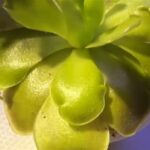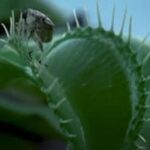As an Amazon Associate, this site earns commissions from qualifying purchases. For more details, click here.
Drosera indica are native in many parts of Southeast Asia, India, Africa and Australia. There are three species of this annual plant: D. indica found in Africa, Southeast Asia, India and Madagascar, D serpentis in Southeast Asia and northwestern Australia and D finlaysoniana, in Laos, Vietnam, China, Taiwan and central Australia.
Drosera indica prefers warm temperature around 80 F (25 C). The soil may include perlite, peat moss or sand and it should be kept moist but not soggy. Keep the plant in bright indirect light for at least 6 hours a day.
Drosera Indica Care Sheet
| Soil | 1:1 peat and perlite, mostly sandy soil, must be moist |
| Water | Distilled, reverse osmosis, rainwater |
| Light | Bright, indirect light 6-8 hours, sunlight and indoor lights are okay |
| Food | Bugs, mealworms, fish pellets |
| Temperature | 60-80 F (15.5-26.6 C) |
| Humidity | 50% |
| Dormancy | Not needed |
| Propagation | Seeds |
Light Requirements
Unlike other sundew that benefit from shade, Drosera indica plants thrive in bright, sunny conditions. The ideal temperature is 80 degrees though the plant will be fine at higher temperatures.
Drosera indica flourish in tropical areas with dry and wet seasons. These plants need at least 6 hours of sunlight though more will not hurt. Direct and indirect sunlight will be fine, though a warmer temperature is preferred.
Drosera needs light to grow and flourish. Without light, the plant cannot do photosynthesis or produce glucose. Lack of light will also make the roots vulnerable to infection and disease.
If the plant will be indoors, place it along a windowsill so it gets warmth. During winter or the rainy season you can set up indoor fixtures like GroDrow Grow Lights to simulate the sun. You can configure it directly on the plant but a few inches away.
If you have Drosera indica seeds, place them under fluorescent light. When leaves appear you can expose them to sunlight. Warm bright light is important for the seeds especially as the plant grows. As long as the temperature does not get too hot (over 100 F for example), the plant will be fine.
There are many ways to tell if drosera is suffering from sunburn and overheating. The leaves feel hot to touch and are dry. Under extreme heat the leaves turn brown and crispy. The dew dries up due to the heat and the plant looks like it is drying up or burning.
These indicators apply to D indica too, but unless you see them, leave it under the sun. The places where it is native to rarely reach this temperature. But you should always be on the lookout and provide shade if the need arises.
Soil and Pot
Drosera indica have different soil requirements. Some species prefer moist soil, others somewhat dry and still others wet.
A soil mixture containing mainly sand works best for Drosera indica. An airy combination of perlite and peat moss are also suitable, but very wet peat soil should be avoided.
Check the instructions that came with your plant to determine the best soil mix. While most drosera prefer moist soil, other species thrive when the ground is almost dry. The Drosera finlaysoniana for instance, grows best in nearly dry soil.
What all sundew species share in common is the need for poor soil. Like other carnivorous plants, drosera obtain nutrients from insects and other prey.
Using potting soil or any type of fertilized soil is going to kill it. Peat moss and sphagnum moss are the most commonly used for carnivorous and insectivorous plants. In the case of Drosera indica however, you should do some research on the species to ensure the right mixture.
You can use almost any type of container to plant drosera, including plastic. Just make sure the pot is deep enough so the roots can spread. The most common drosera pot sizes are 4 and 10 inches.
The biggest benefit of using a deep container is the plant will have room to grow. Otherwise you will need to repot as it grows.
On the other hand, a deep pot might require more water to reach the plant roots. Check the soil if it is wet enough and you will know whether to add more water or not.
Because the soil requirements vary, you should do some research on the species before you buy. This will save you a lot of trouble later on when planting. With enough preparation you should have no issues with the soil though.
Water Requirements
Drosera indica plants have diverse water requirements. D finlaysoniana prefers mostly – not completely – dry soil. Other species prefer wetter conditions, so it will depend on where the seeds are native to.
If your Drosera indica prefers a drier soil, water it from the top. While other drosera benefit from sitting in water, D finlaysoniana does not. Water it from the top like a regular houseplant. You should only water again when the soil is almost completely dry.
Other drosera have to be kept constantly wet. In this case you should use the tray method. Fill a tray with an inch or two of water and place the drosera pot there.
This is a more effective method than watering from the top. The water finds its way into the plant through the drainage hole in the container. Not only that, but humidity stays high because the plant is sitting in water.
During summer you have to strike a balance between warmth and heat. These plants need warmth but too much heat is bad. With the tray method you can give the plant all the light it needs while maintaining high humidity.
Keep in mind this is only for Drosera indica that prefer wet conditions. If the plant thrives in drier settings you should use the water from top method.
The varying soil and water requirements means caring for Drosera indica is more complex than other sundew plants. Even so, you can make things easier for yourself and the plant by learning as much as you can about their natural habitat.
Your goal is to simulate the natural habitat of the plant as much as possible. Once you know how much – or how little – water the plant needs, you can grow it with confidence.
How to Grow Drosera Indica Seeds
In the tropics where Drosera indica is found, the seeds grow during the rainy season. At home, you need to provide wet conditions that simulate this. How wet depends on the water and soil requirements of that species.
First you have to prepare the soil. As already stated, most Drosera indica thrive in soil comprised of mostly sand or a combination of perlite and peat.
Sow the seeds and set in a sunlit location, up to 80 degrees. If natural light is not available you can use artificial light. However you should store the seeds in a bag before exposing them to light. You can remove the bag when leaves have sprouted.
You can start feeding as soon as some leaves appear. Wait until there is dew on the leaves before giving it any food.
If you bought freeze dried food like Ranz Dried Mealworms, dip them in water first before giving it to the plant. Next, drop the worm into the leaves.
Drosera indica seeds can grow quickly with enough nutrients, light, water and soil. As it grows, keep an eye on the pot if it is large enough or has to be repotted.
Regardless how old the plant is, you should only feed it when there is dew. It is normal for very young sundews to have little dew. Over time more will appear. But if an adult sundew has little to no dew, this guide can help you find out why. You can feed the plant when dew has appeared.
Lastly, these are annual plants so they will not grow back during spring. They also do not propagate with leaf cuttings either. Your best option is to start over with seeds using the growth methods stated here.
Conclusion
Drosera indica have a reputation as being challenging to grow, but with the proper approach it can be done. Even if it is your first time to care for this plant, there is no need to worry as long as you follow the guidelines here.

My fascination with carnivorous plants began many, many years ago with Venus Fly Traps. Now I am more than happy to impart what I know with other enthusiasts and those who are curious about meat eating plants.



